Shu Kong
Robust Few-Shot Vision-Language Model Adaptation
Jun 05, 2025Abstract:Pretrained VLMs achieve strong performance on downstream tasks when adapted with just a few labeled examples. As the adapted models inevitably encounter out-of-distribution (OOD) test data that deviates from the in-distribution (ID) task-specific training data, enhancing OOD generalization in few-shot adaptation is critically important. We study robust few-shot VLM adaptation, aiming to increase both ID and OOD accuracy. By comparing different adaptation methods (e.g., prompt tuning, linear probing, contrastive finetuning, and full finetuning), we uncover three key findings: (1) finetuning with proper hyperparameters significantly outperforms the popular VLM adaptation methods prompt tuning and linear probing; (2) visual encoder-only finetuning achieves better efficiency and accuracy than contrastively finetuning both visual and textual encoders; (3) finetuning the top layers of the visual encoder provides the best balance between ID and OOD accuracy. Building on these findings, we propose partial finetuning of the visual encoder empowered with two simple augmentation techniques: (1) retrieval augmentation which retrieves task-relevant data from the VLM's pretraining dataset to enhance adaptation, and (2) adversarial perturbation which promotes robustness during finetuning. Results show that the former/latter boosts OOD/ID accuracy while slightly sacrificing the ID/OOD accuracy. Yet, perhaps understandably, naively combining the two does not maintain their best OOD/ID accuracy. We address this dilemma with the developed SRAPF, Stage-wise Retrieval Augmentation-based Adversarial Partial Finetuning. SRAPF consists of two stages: (1) partial finetuning the visual encoder using both ID and retrieved data, and (2) adversarial partial finetuning with few-shot ID data. Extensive experiments demonstrate that SRAPF achieves the state-of-the-art ID and OOD accuracy on the ImageNet OOD benchmarks.
UAL-Bench: The First Comprehensive Unusual Activity Localization Benchmark
Oct 02, 2024Abstract:Localizing unusual activities, such as human errors or surveillance incidents, in videos holds practical significance. However, current video understanding models struggle with localizing these unusual events likely because of their insufficient representation in models' pretraining datasets. To explore foundation models' capability in localizing unusual activity, we introduce UAL-Bench, a comprehensive benchmark for unusual activity localization, featuring three video datasets: UAG-OOPS, UAG-SSBD, UAG-FunQA, and an instruction-tune dataset: OOPS-UAG-Instruct, to improve model capabilities. UAL-Bench evaluates three approaches: Video-Language Models (Vid-LLMs), instruction-tuned Vid-LLMs, and a novel integration of Vision-Language Models and Large Language Models (VLM-LLM). Our results show the VLM-LLM approach excels in localizing short-span unusual events and predicting their onset (start time) more accurately than Vid-LLMs. We also propose a new metric, R@1, TD <= p, to address limitations in existing evaluation methods. Our findings highlight the challenges posed by long-duration videos, particularly in autism diagnosis scenarios, and the need for further advancements in localization techniques. Our work not only provides a benchmark for unusual activity localization but also outlines the key challenges for existing foundation models, suggesting future research directions on this important task.
Lidar Panoptic Segmentation in an Open World
Sep 22, 2024Abstract:Addressing Lidar Panoptic Segmentation (LPS ) is crucial for safe deployment of autonomous vehicles. LPS aims to recognize and segment lidar points w.r.t. a pre-defined vocabulary of semantic classes, including thing classes of countable objects (e.g., pedestrians and vehicles) and stuff classes of amorphous regions (e.g., vegetation and road). Importantly, LPS requires segmenting individual thing instances (e.g., every single vehicle). Current LPS methods make an unrealistic assumption that the semantic class vocabulary is fixed in the real open world, but in fact, class ontologies usually evolve over time as robots encounter instances of novel classes that are considered to be unknowns w.r.t. the pre-defined class vocabulary. To address this unrealistic assumption, we study LPS in the Open World (LiPSOW): we train models on a dataset with a pre-defined semantic class vocabulary and study their generalization to a larger dataset where novel instances of thing and stuff classes can appear. This experimental setting leads to interesting conclusions. While prior art train class-specific instance segmentation methods and obtain state-of-the-art results on known classes, methods based on class-agnostic bottom-up grouping perform favorably on classes outside of the initial class vocabulary (i.e., unknown classes). Unfortunately, these methods do not perform on-par with fully data-driven methods on known classes. Our work suggests a middle ground: we perform class-agnostic point clustering and over-segment the input cloud in a hierarchical fashion, followed by binary point segment classification, akin to Region Proposal Network [1]. We obtain the final point cloud segmentation by computing a cut in the weighted hierarchical tree of point segments, independently of semantic classification. Remarkably, this unified approach leads to strong performance on both known and unknown classes.
LCA-on-the-Line: Benchmarking Out-of-Distribution Generalization with Class Taxonomies
Jul 22, 2024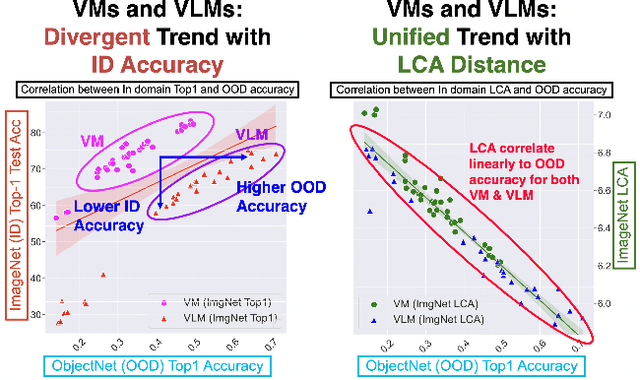

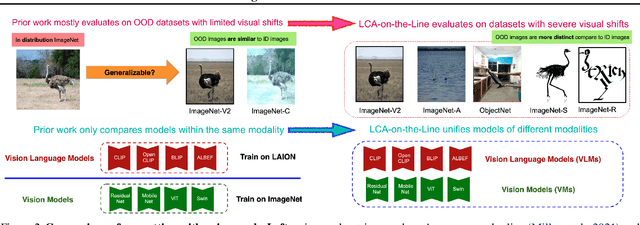

Abstract:We tackle the challenge of predicting models' Out-of-Distribution (OOD) performance using in-distribution (ID) measurements without requiring OOD data. Existing evaluations with "Effective Robustness", which use ID accuracy as an indicator of OOD accuracy, encounter limitations when models are trained with diverse supervision and distributions, such as class labels (Vision Models, VMs, on ImageNet) and textual descriptions (Visual-Language Models, VLMs, on LAION). VLMs often generalize better to OOD data than VMs despite having similar or lower ID performance. To improve the prediction of models' OOD performance from ID measurements, we introduce the Lowest Common Ancestor (LCA)-on-the-Line framework. This approach revisits the established concept of LCA distance, which measures the hierarchical distance between labels and predictions within a predefined class hierarchy, such as WordNet. We assess 75 models using ImageNet as the ID dataset and five significantly shifted OOD variants, uncovering a strong linear correlation between ID LCA distance and OOD top-1 accuracy. Our method provides a compelling alternative for understanding why VLMs tend to generalize better. Additionally, we propose a technique to construct a taxonomic hierarchy on any dataset using K-means clustering, demonstrating that LCA distance is robust to the constructed taxonomic hierarchy. Moreover, we demonstrate that aligning model predictions with class taxonomies, through soft labels or prompt engineering, can enhance model generalization. Open source code in our Project Page: https://elvishelvis.github.io/papers/lca/.
Few-Shot Recognition via Stage-Wise Augmented Finetuning
Jun 17, 2024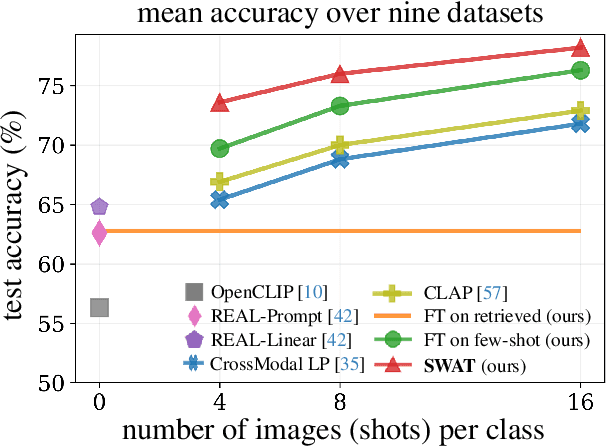

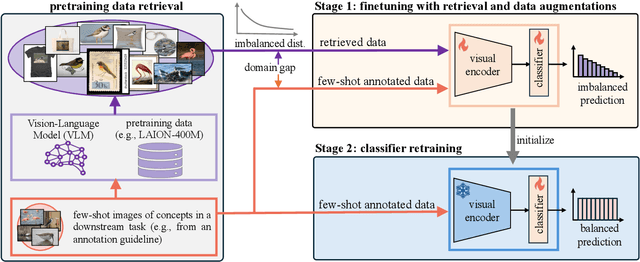
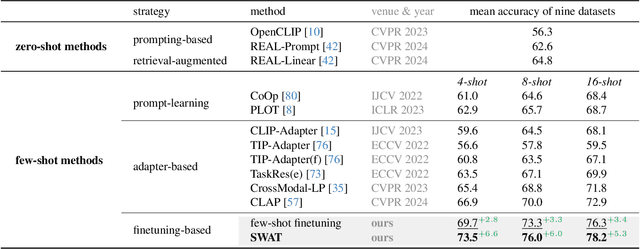
Abstract:Few-shot recognition aims to train a classification model with only a few labeled examples of pre-defined concepts, where annotation can be costly in a downstream task. In another related research area, zero-shot recognition, which assumes no access to any downstream-task data, has been greatly advanced by using pretrained Vision-Language Models (VLMs). In this area, retrieval-augmented learning (RAL) effectively boosts zero-shot accuracy by retrieving and learning from external data relevant to downstream concepts. Motivated by these advancements, our work explores RAL for few-shot recognition. While seemingly straightforward despite being under-explored in the literature (till now!), we present novel challenges and opportunities for applying RAL for few-shot recognition. First, perhaps surprisingly, simply finetuning the VLM on a large amount of retrieved data barely surpasses state-of-the-art zero-shot methods due to the imbalanced distribution of retrieved data and its domain gaps compared to few-shot annotated data. Second, finetuning a VLM on few-shot examples alone significantly outperforms prior methods, and finetuning on the mix of retrieved and few-shot data yields even better results. Third, to mitigate the imbalanced distribution and domain gap issue, we propose Stage-Wise Augmented fineTuning (SWAT) method, which involves end-to-end finetuning on mixed data for the first stage and retraining the classifier solely on the few-shot data in the second stage. Extensive experiments show that SWAT achieves the best performance on standard benchmark datasets, resoundingly outperforming prior works by ~10% in accuracy. Code is available at https://github.com/tian1327/SWAT.
CriSp: Leveraging Tread Depth Maps for Enhanced Crime-Scene Shoeprint Matching
Apr 25, 2024Abstract:Shoeprints are a common type of evidence found at crime scenes and are used regularly in forensic investigations. However, existing methods cannot effectively employ deep learning techniques to match noisy and occluded crime-scene shoeprints to a shoe database due to a lack of training data. Moreover, all existing methods match crime-scene shoeprints to clean reference prints, yet our analysis shows matching to more informative tread depth maps yields better retrieval results. The matching task is further complicated by the necessity to identify similarities only in corresponding regions (heels, toes, etc) of prints and shoe treads. To overcome these challenges, we leverage shoe tread images from online retailers and utilize an off-the-shelf predictor to estimate depth maps and clean prints. Our method, named CriSp, matches crime-scene shoeprints to tread depth maps by training on this data. CriSp incorporates data augmentation to simulate crime-scene shoeprints, an encoder to learn spatially-aware features, and a masking module to ensure only visible regions of crime-scene prints affect retrieval results. To validate our approach, we introduce two validation sets by reprocessing existing datasets of crime-scene shoeprints and establish a benchmarking protocol for comparison. On this benchmark, CriSp significantly outperforms state-of-the-art methods in both automated shoeprint matching and image retrieval tailored to this task.
Roadside Monocular 3D Detection via 2D Detection Prompting
Apr 04, 2024



Abstract:The problem of roadside monocular 3D detection requires detecting objects of interested classes in a 2D RGB frame and predicting their 3D information such as locations in bird's-eye-view (BEV). It has broad applications in traffic control, vehicle-vehicle communication, and vehicle-infrastructure cooperative perception. To approach this problem, we present a novel and simple method by prompting the 3D detector using 2D detections. Our method builds on a key insight that, compared with 3D detectors, a 2D detector is much easier to train and performs significantly better w.r.t detections on the 2D image plane. That said, one can exploit 2D detections of a well-trained 2D detector as prompts to a 3D detector, being trained in a way of inflating such 2D detections to 3D towards 3D detection. To construct better prompts using the 2D detector, we explore three techniques: (a) concatenating both 2D and 3D detectors' features, (b) attentively fusing 2D and 3D detectors' features, and (c) encoding predicted 2D boxes x, y, width, height, label and attentively fusing such with the 3D detector's features. Surprisingly, the third performs the best. Moreover, we present a yaw tuning tactic and a class-grouping strategy that merges classes based on their functionality; these techniques improve 3D detection performance further. Comprehensive ablation studies and extensive experiments demonstrate that our method resoundingly outperforms prior works, achieving the state-of-the-art on two large-scale roadside 3D detection benchmarks.
Boosting Image Restoration via Priors from Pre-trained Models
Mar 19, 2024



Abstract:Pre-trained models with large-scale training data, such as CLIP and Stable Diffusion, have demonstrated remarkable performance in various high-level computer vision tasks such as image understanding and generation from language descriptions. Yet, their potential for low-level tasks such as image restoration remains relatively unexplored. In this paper, we explore such models to enhance image restoration. As off-the-shelf features (OSF) from pre-trained models do not directly serve image restoration, we propose to learn an additional lightweight module called Pre-Train-Guided Refinement Module (PTG-RM) to refine restoration results of a target restoration network with OSF. PTG-RM consists of two components, Pre-Train-Guided Spatial-Varying Enhancement (PTG-SVE), and Pre-Train-Guided Channel-Spatial Attention (PTG-CSA). PTG-SVE enables optimal short- and long-range neural operations, while PTG-CSA enhances spatial-channel attention for restoration-related learning. Extensive experiments demonstrate that PTG-RM, with its compact size ($<$1M parameters), effectively enhances restoration performance of various models across different tasks, including low-light enhancement, deraining, deblurring, and denoising.
The Neglected Tails of Vision-Language Models
Feb 02, 2024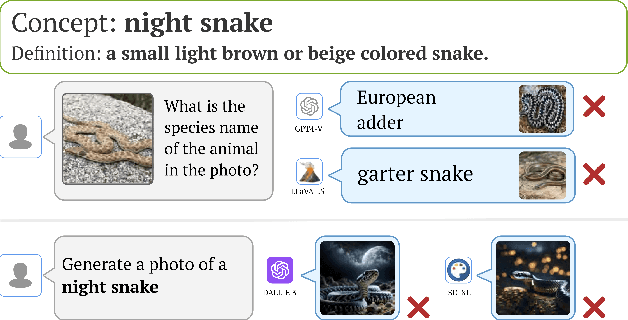

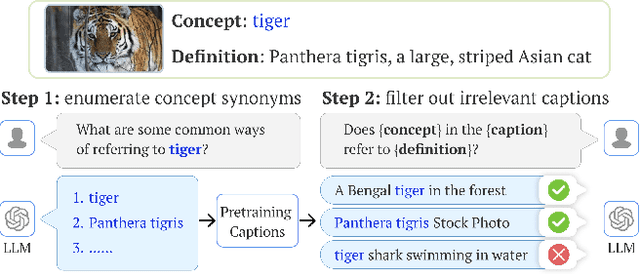
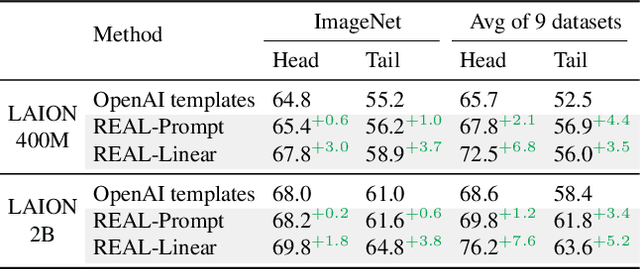
Abstract:Vision-language models (VLMs) excel in zero-shot recognition but their performance varies greatly across different visual concepts. For example, although CLIP achieves impressive accuracy on ImageNet (60-80%), its performance drops below 10% for more than ten concepts like night snake, presumably due to their limited presence in the pretraining data. However, measuring the frequency of concepts in VLMs' large-scale datasets is challenging. We address this by using large language models (LLMs) to count the number of pretraining texts that contain synonyms of these concepts. Our analysis confirms that popular datasets, such as LAION, exhibit a long-tailed concept distribution, yielding biased performance in VLMs. We also find that downstream applications of VLMs, including visual chatbots (e.g., GPT-4V) and text-to-image models (e.g., Stable Diffusion), often fail to recognize or generate images of rare concepts identified by our method. To mitigate the imbalanced performance of zero-shot VLMs, we propose REtrieval-Augmented Learning (REAL). First, instead of prompting VLMs using the original class names, REAL uses their most frequent synonyms found in pretraining texts. This simple change already outperforms costly human-engineered and LLM-enriched prompts over nine benchmark datasets. Second, REAL trains a linear classifier on a small yet balanced set of pretraining data retrieved using concept synonyms. REAL surpasses the previous zero-shot SOTA, using 400x less storage and 10,000x less training time!
AccessLens: Auto-detecting Inaccessibility of Everyday Objects
Jan 29, 2024Abstract:In our increasingly diverse society, everyday physical interfaces often present barriers, impacting individuals across various contexts. This oversight, from small cabinet knobs to identical wall switches that can pose different contextual challenges, highlights an imperative need for solutions. Leveraging low-cost 3D-printed augmentations such as knob magnifiers and tactile labels seems promising, yet the process of discovering unrecognized barriers remains challenging because disability is context-dependent. We introduce AccessLens, an end-to-end system designed to identify inaccessible interfaces in daily objects, and recommend 3D-printable augmentations for accessibility enhancement. Our approach involves training a detector using the novel AccessDB dataset designed to automatically recognize 21 distinct Inaccessibility Classes (e.g., bar-small and round-rotate) within 6 common object categories (e.g., handle and knob). AccessMeta serves as a robust way to build a comprehensive dictionary linking these accessibility classes to open-source 3D augmentation designs. Experiments demonstrate our detector's performance in detecting inaccessible objects.
 Add to Chrome
Add to Chrome Add to Firefox
Add to Firefox Add to Edge
Add to Edge